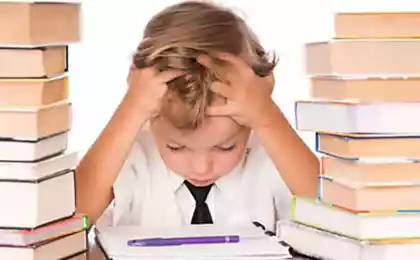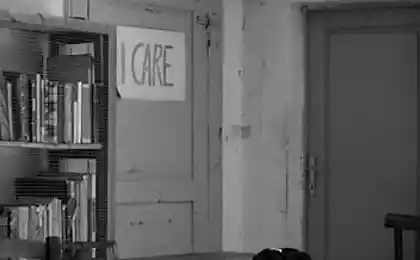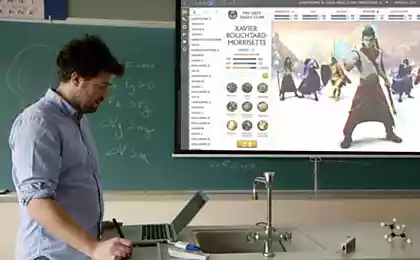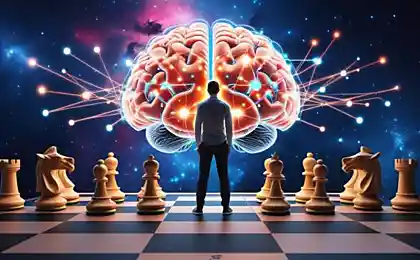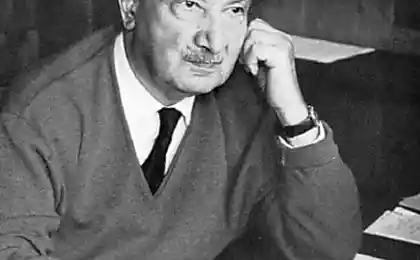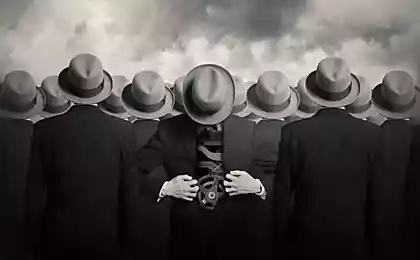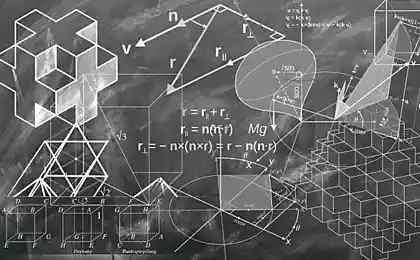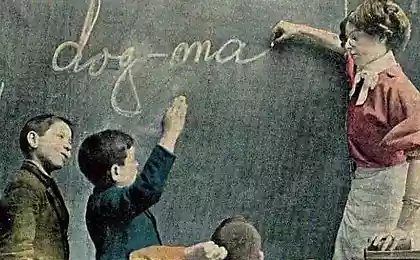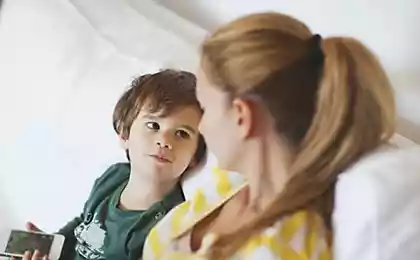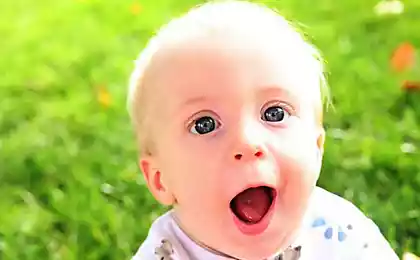651
Unteachable pupils: children with no motivation
A phenomenon peculiar to our modern culture: children are capable, but without motivation, clever, but not achievers in school, smart but bored. Teachers acknowledge that teaching was harder and the students are now less deferential and less sensitive. The learning process has become more intense than it was a decade or two ago.
Changing models of attachment to our children is extremely negative impact on the learning...
The learning of each individual student depends on many factors: the desire to learn and understand, interest in the unknown, willingness to risk, openness to influence and criticism.
Also need contact with the teacher, attentiveness, willingness to ask for help, the desire to achieve and succeed, and, especially, willingness to work hard. Attachment is the basis of all of these factors affect their occurrence.
Upon closer examination we can understand that the susceptibility of a child to learning identify four basic qualities: natural curiosity, integrative thinking, the ability to benefit from criticism and the contact with the teacher. The presence of a healthy attachment strengthens each of these four qualities, and orientation to peers, on the contrary, affects them negatively.

Orientation to peers kills curiosity.
Children with energy of passion usually have a keen interest in specific areas of knowledge and really keen to learn. They get great pleasure coaching intuition and delving into the essence of things. These children put common tasks in training, I like to be original and learn to master them. The pupils happily take responsibility and aspire to realize your potential.
If these children do not always do well in school, most likely because they have their own idea of what they want to learn, and perceive the proposed curriculum as something imposed.
From the point of view of development, curiosity is a luxury. Affection – that's what matters most. Until then, until you are released ounce of energy, leaving the search for a safe and secure attachment, moving forward, new discoveries, impossible. For this reason, orientation to peers kills curiosity.
In addition, curiosity makes a child extremely vulnerable in a world of “cool” peers. For the naive wonder and passion for the subject, for the question “how it works” and originality of the ideas it can shame and ridicule. Thus, orientation to peers jeopardizes the phenomenon of curiosity.
Orientation to peers dulls integrative thinking.
To motivate yourself is very important integrative thinking – thinking that is able to simultaneously process the conflicting thoughts and feelings. The child with well-developed integrative abilities reluctance to go to school is connected with concern about missed classes, reluctance to get up in the morning kompensiruet the fear of being late. The desire to succeed inhibits the unwillingness to listen to the teacher, fear of troubles harnesses unwillingness to obey.
To integrative learning was successful, the child must be Mature enough and able to withstand the duality of opinions: experience mixed feelings, on reflection, to change his mind, to experience conflicting emotions. For the emergence of the balancing element – the component that dampens the pulses that negatively affect learning – the child is also necessary for a strong attachment.
It should be able to feel deeply vulnerable. For example, the child needs to be linked to parents or teachers so much that he cared what they think, what they expect from him, not upset if they are not moving away from him.Invulnerability and disregard paralyze the learning and doing of the child uneducable.
Integrative thinking is necessary to ensure that training is not turned into simple rote learning. To solve the problem, the student should be able to think from several perspectives. You want not only to see the simple facts but also to reveal the essence of things, to understand the deep meaning, to grasp the metaphor, to open the fundamental principles.
The student must know how to identify the main, cleared from the husk, and, conversely, how to fold the parts into a harmonious whole. Everything that goes beyond concrete thinking, requires an integrative perception.
For full-time study required the ability to see things at least from two points of view. If thinking one-dimensional, it lacks depth and perspective, ability to synthesis and analysis capabilities to understand the truth and deep meanings. In this case, the context is not taken into account, the image and background are almost indistinguishable.
Unfortunately, the narrow thinking of the student are not automatically converted to integrative. Integrative activity is a product of growing up that orientation to peers inhibits. The immature person is unable to develop integrative skills.
Our pedagogy and curriculum to accept the presence of the integrative abilities of the child as a reality. We're trying to get kids to do something that's beyond our mental abilities, and when it fails, we punish them for failure.
Those who have integrative thinking, believe that all think the same as them. However, children who do not have the integrative mindset, not receptive to this kind of training, it requires a different approach. Focused on peers, adolescents tend to be weak students unable to think, feel and act.
Orientation to peers jeopardizes the learning by trial and error.
A large part of the learning process is performed through adaptation, through trial and error. We try to tackle new tasks, make mistakes, run into stumbling blocks, wrong, make the appropriate conclusions, or someone makes them for us.
Failures are an integral part of the educational process, therefore, the principal tool of study is the criticism. “The flight from vulnerability” caused by the orientation of peers, three deals a crushing blow to this type of training.
The first blow strikes the empirical part of the process.
To learn new things is to risk: to read aloud, to Express their opinion, to embark on unfamiliar territory, experimenting with ideas. Similar experiences – it's a minefield of possible errors, unpredictable reactions, negative feedback. When vulnerability is already impossible to handle, as it happens in most teen-focused children, these risks seem unacceptable.
The second strike undermines the ability based on the age of the child to learn from mistakes. To learn from their mistakes, we first need to recognize them and realize their failure. If we really want to benefit from it, you need to take responsibility and accept help, advice and criticism.
The brain is protected from the vulnerability of children abstrahierte from all that can make them feel vulnerable, in this case, from the recognition of mistakes and failures. An indication of what he has done wrong, will cause the child's resistance and hostility.
Adults often regard this reaction as being rude, but actually this way the child is protected in order not to feel our own vulnerability. When the child is too protected from the vulnerability, the awareness of the futility of action does not penetrate into it. This is the third strike by the method of trial and error.
Frustration must go into a sense of futility, and then we can come to terms with the way things are. To “register” the sense of futility is the essence of adaptive learning. When emotions are so numb that we don't feel sadness or frustration reaching the goal, we never learn, we don't release the frustration. In the case of students, the external target will be “stupid” teacher, boring assignments and lack of time. Internal target is the pupil, and then there are reactions like “I'm so stupid”.
In any case, the sadness will not go into anger, emotions associated with genuine experience of futility, doesn't come out. Habitual style of behavior will not change the educational approach, too, and the obstacles are not overcome. Children “stuck” in this manner, do not learn to benefit from failure and criticism. They are bogged down that they fail.
Children-oriented peers, learn from the feelings of affection, even if it is attached to the wrong teachers.
From the point of view of development, there are 4 main types of educational process. Orientation to peers has a negative impact on 3 of them: on the process of formation, integration and adaptation. Students with energy of passion, necessary to the teacher, who will put their interests at the forefront. Students with the integrative thinking face conflicting factors that must be considered when solving problems.
Students ' adaptive type of learning process is conducted through the criticism and trial and error. These children are able to learn, even without attachment to the teacher. If we exclude these key processes, the training will be due to only one driving force – attachment.
Students who do not have the energy of formation, integrative and adaptive ability, can learn only when there is attachment. The desire to learn may not be deep, but strong enough if it is motivated by a strong need to be around adult teaching, whether the teacher in the classroom or learning-at-home parent, or family friend, acting as a mentor.
Attachment is the most powerful driving force in education and, of course, sufficient to perform taskseven without the help of curiosity or ability to benefit from criticism. Students focused on attachment is guided by motives, not typical of other students.
For example, they are more inclined to learn through imitation, copying, memorizing, good at taking signals. Such students want to be worse than others, and will try to work in order to assert themselves to gain recognition and location. The problem arises not when the learning process is carried out only through affection, and when children begin to become attached to peers than to the teacher.
The child, accustomed to study only through the attachment down the right path orientation to peers, learning will be reduced significantly, however promising natural potential he may possess. Some children consciously decide to “move in school”.
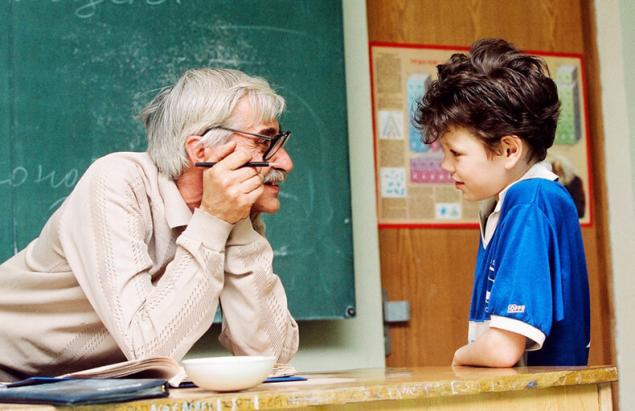
Orientation to peers makes the study irrelevant.
For the oriented peers adolescent subjects are not important.
Children, adolescents, intuitively, and, most importantly friends and stay with them.
Orientation towards peers steals teachers from students.
Immature young people learn helps attachment. The smaller the child's energy of formation, integrative and adaptive abilities, the more he depends on the affection. Children, adult-oriented look at them as the compass indicating the coordinates and direction of movement. In this case, they will be loyal to the teacher than the group of peers and will perceive the teacher as a role model, authority and inspiration.
Children's attachment to the teacher gives the last natural force to guide the child's behavior, to show his good intentions, to instill social values.
Let go of the son in man's world! The men's education for menThese words— the worst curse a parent
Kids learn better when they love their teacher and believe that the teacher loves them. As you know, the path to thoughts of the child lies through his feelings. Children based on their age, automatically become disciples focused on attachment, not having the energy of formation and unable to integrative and adaptive learning. The problem is that are aimed in the wrong direction affection that makes them do about learning not let those “teachers”.
Focused on peers, students become less dependent on the teacher, obviously to the delight of most of the overloaded teachers. Such students will not achieve academic success. The teacher may direct, only if the disciples follow him, and the disciples will go only for the teacher to whom affection. published
G. Neufeld. G. Mate. Chapter 13 – "Unteachable" students
Source: alpha-parenting.ru/2016/09/26/gordon-neufeld-glava-13-neobuchaemyie-ucheniki/
Changing models of attachment to our children is extremely negative impact on the learning...
The learning of each individual student depends on many factors: the desire to learn and understand, interest in the unknown, willingness to risk, openness to influence and criticism.
Also need contact with the teacher, attentiveness, willingness to ask for help, the desire to achieve and succeed, and, especially, willingness to work hard. Attachment is the basis of all of these factors affect their occurrence.
Upon closer examination we can understand that the susceptibility of a child to learning identify four basic qualities: natural curiosity, integrative thinking, the ability to benefit from criticism and the contact with the teacher. The presence of a healthy attachment strengthens each of these four qualities, and orientation to peers, on the contrary, affects them negatively.

Orientation to peers kills curiosity.
Children with energy of passion usually have a keen interest in specific areas of knowledge and really keen to learn. They get great pleasure coaching intuition and delving into the essence of things. These children put common tasks in training, I like to be original and learn to master them. The pupils happily take responsibility and aspire to realize your potential.
If these children do not always do well in school, most likely because they have their own idea of what they want to learn, and perceive the proposed curriculum as something imposed.
From the point of view of development, curiosity is a luxury. Affection – that's what matters most. Until then, until you are released ounce of energy, leaving the search for a safe and secure attachment, moving forward, new discoveries, impossible. For this reason, orientation to peers kills curiosity.
In addition, curiosity makes a child extremely vulnerable in a world of “cool” peers. For the naive wonder and passion for the subject, for the question “how it works” and originality of the ideas it can shame and ridicule. Thus, orientation to peers jeopardizes the phenomenon of curiosity.
Orientation to peers dulls integrative thinking.
To motivate yourself is very important integrative thinking – thinking that is able to simultaneously process the conflicting thoughts and feelings. The child with well-developed integrative abilities reluctance to go to school is connected with concern about missed classes, reluctance to get up in the morning kompensiruet the fear of being late. The desire to succeed inhibits the unwillingness to listen to the teacher, fear of troubles harnesses unwillingness to obey.
To integrative learning was successful, the child must be Mature enough and able to withstand the duality of opinions: experience mixed feelings, on reflection, to change his mind, to experience conflicting emotions. For the emergence of the balancing element – the component that dampens the pulses that negatively affect learning – the child is also necessary for a strong attachment.
It should be able to feel deeply vulnerable. For example, the child needs to be linked to parents or teachers so much that he cared what they think, what they expect from him, not upset if they are not moving away from him.Invulnerability and disregard paralyze the learning and doing of the child uneducable.
Integrative thinking is necessary to ensure that training is not turned into simple rote learning. To solve the problem, the student should be able to think from several perspectives. You want not only to see the simple facts but also to reveal the essence of things, to understand the deep meaning, to grasp the metaphor, to open the fundamental principles.
The student must know how to identify the main, cleared from the husk, and, conversely, how to fold the parts into a harmonious whole. Everything that goes beyond concrete thinking, requires an integrative perception.
For full-time study required the ability to see things at least from two points of view. If thinking one-dimensional, it lacks depth and perspective, ability to synthesis and analysis capabilities to understand the truth and deep meanings. In this case, the context is not taken into account, the image and background are almost indistinguishable.
Unfortunately, the narrow thinking of the student are not automatically converted to integrative. Integrative activity is a product of growing up that orientation to peers inhibits. The immature person is unable to develop integrative skills.
Our pedagogy and curriculum to accept the presence of the integrative abilities of the child as a reality. We're trying to get kids to do something that's beyond our mental abilities, and when it fails, we punish them for failure.
Those who have integrative thinking, believe that all think the same as them. However, children who do not have the integrative mindset, not receptive to this kind of training, it requires a different approach. Focused on peers, adolescents tend to be weak students unable to think, feel and act.
Orientation to peers jeopardizes the learning by trial and error.
A large part of the learning process is performed through adaptation, through trial and error. We try to tackle new tasks, make mistakes, run into stumbling blocks, wrong, make the appropriate conclusions, or someone makes them for us.
Failures are an integral part of the educational process, therefore, the principal tool of study is the criticism. “The flight from vulnerability” caused by the orientation of peers, three deals a crushing blow to this type of training.
The first blow strikes the empirical part of the process.
To learn new things is to risk: to read aloud, to Express their opinion, to embark on unfamiliar territory, experimenting with ideas. Similar experiences – it's a minefield of possible errors, unpredictable reactions, negative feedback. When vulnerability is already impossible to handle, as it happens in most teen-focused children, these risks seem unacceptable.
The second strike undermines the ability based on the age of the child to learn from mistakes. To learn from their mistakes, we first need to recognize them and realize their failure. If we really want to benefit from it, you need to take responsibility and accept help, advice and criticism.
The brain is protected from the vulnerability of children abstrahierte from all that can make them feel vulnerable, in this case, from the recognition of mistakes and failures. An indication of what he has done wrong, will cause the child's resistance and hostility.
Adults often regard this reaction as being rude, but actually this way the child is protected in order not to feel our own vulnerability. When the child is too protected from the vulnerability, the awareness of the futility of action does not penetrate into it. This is the third strike by the method of trial and error.
Frustration must go into a sense of futility, and then we can come to terms with the way things are. To “register” the sense of futility is the essence of adaptive learning. When emotions are so numb that we don't feel sadness or frustration reaching the goal, we never learn, we don't release the frustration. In the case of students, the external target will be “stupid” teacher, boring assignments and lack of time. Internal target is the pupil, and then there are reactions like “I'm so stupid”.
In any case, the sadness will not go into anger, emotions associated with genuine experience of futility, doesn't come out. Habitual style of behavior will not change the educational approach, too, and the obstacles are not overcome. Children “stuck” in this manner, do not learn to benefit from failure and criticism. They are bogged down that they fail.
Children-oriented peers, learn from the feelings of affection, even if it is attached to the wrong teachers.
From the point of view of development, there are 4 main types of educational process. Orientation to peers has a negative impact on 3 of them: on the process of formation, integration and adaptation. Students with energy of passion, necessary to the teacher, who will put their interests at the forefront. Students with the integrative thinking face conflicting factors that must be considered when solving problems.
Students ' adaptive type of learning process is conducted through the criticism and trial and error. These children are able to learn, even without attachment to the teacher. If we exclude these key processes, the training will be due to only one driving force – attachment.
Students who do not have the energy of formation, integrative and adaptive ability, can learn only when there is attachment. The desire to learn may not be deep, but strong enough if it is motivated by a strong need to be around adult teaching, whether the teacher in the classroom or learning-at-home parent, or family friend, acting as a mentor.
Attachment is the most powerful driving force in education and, of course, sufficient to perform taskseven without the help of curiosity or ability to benefit from criticism. Students focused on attachment is guided by motives, not typical of other students.
For example, they are more inclined to learn through imitation, copying, memorizing, good at taking signals. Such students want to be worse than others, and will try to work in order to assert themselves to gain recognition and location. The problem arises not when the learning process is carried out only through affection, and when children begin to become attached to peers than to the teacher.
The child, accustomed to study only through the attachment down the right path orientation to peers, learning will be reduced significantly, however promising natural potential he may possess. Some children consciously decide to “move in school”.

Orientation to peers makes the study irrelevant.
For the oriented peers adolescent subjects are not important.
Children, adolescents, intuitively, and, most importantly friends and stay with them.
Orientation towards peers steals teachers from students.
Immature young people learn helps attachment. The smaller the child's energy of formation, integrative and adaptive abilities, the more he depends on the affection. Children, adult-oriented look at them as the compass indicating the coordinates and direction of movement. In this case, they will be loyal to the teacher than the group of peers and will perceive the teacher as a role model, authority and inspiration.
Children's attachment to the teacher gives the last natural force to guide the child's behavior, to show his good intentions, to instill social values.
Let go of the son in man's world! The men's education for menThese words— the worst curse a parent
Kids learn better when they love their teacher and believe that the teacher loves them. As you know, the path to thoughts of the child lies through his feelings. Children based on their age, automatically become disciples focused on attachment, not having the energy of formation and unable to integrative and adaptive learning. The problem is that are aimed in the wrong direction affection that makes them do about learning not let those “teachers”.
Focused on peers, students become less dependent on the teacher, obviously to the delight of most of the overloaded teachers. Such students will not achieve academic success. The teacher may direct, only if the disciples follow him, and the disciples will go only for the teacher to whom affection. published
G. Neufeld. G. Mate. Chapter 13 – "Unteachable" students
Source: alpha-parenting.ru/2016/09/26/gordon-neufeld-glava-13-neobuchaemyie-ucheniki/
How to unlock the sciatic nerve: 2 simple ways to relieve the pain
Mercedes introduced the 408-strong electrocreaser


